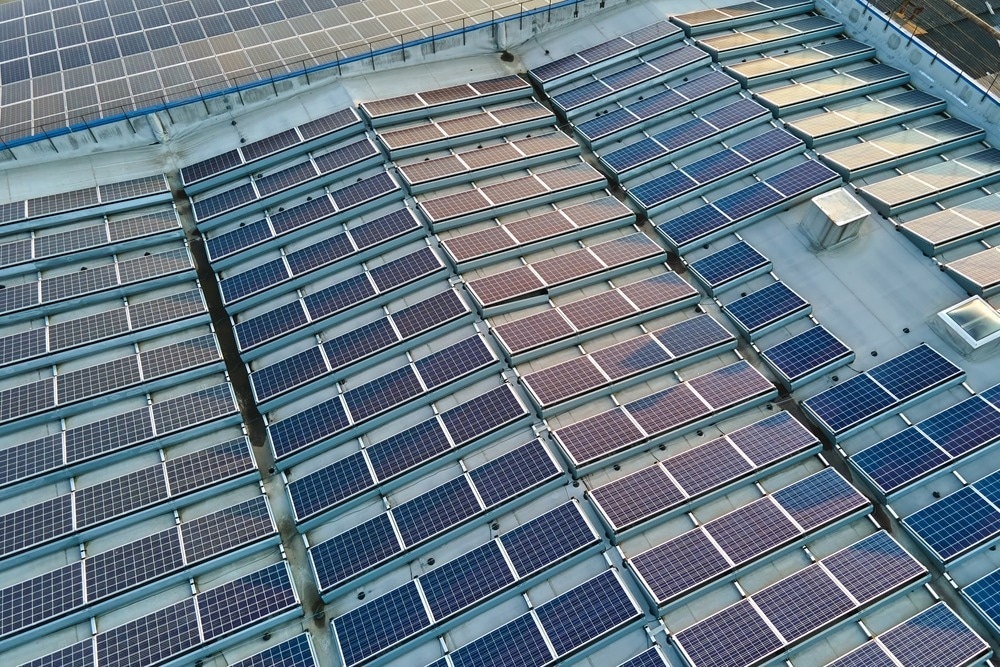Sustainable architecture is a growing trend in urban design. In recent years, several projects have sought to connect architecture with energy generation, utilizing solar power to drastically reduce the carbon footprint of the construction sector.
It is not just about functionality, however: solar architecture projects aim to marry practicality and sustainability with aesthetic design. This article will discuss the benefits of solar architecture and explore some notable current projects in this innovative design field.

Image Credit: Bilanol/Shutterstock.com
Solar Architecture
The history of building with the sun in mind stretches back many millennia: ancient societies such as the Greeks and Ancestral Puebloans in North America recognized the value of using passive solar design principles to maintain internal ambient temperatures.
The climate crisis has crystallized a need for action, fostering innovative approaches. The construction industry has long been recognized as one of the key emitters of greenhouse gases: concrete production alone is responsible for around 8% of all global CO2 emissions.
Factors such as embedded carbon emissions, lifetime emissions, transportation, the use of fossil fuels to run plant equipment, and the extraction of vast amounts of virgin materials all contribute to the sector’s environmental impact.
Dubai World Expo - Dutch Pavilion - Marjan van Aubel Studio
Video Credit: Marjan van Aubel Studio/Youtube.com
Solar architectural principles are a potential solution to the issues faced by architecture and construction. Architects and engineers working in this field strive to implement ecologically sympathetic designs and lower the energy load for new and extant buildings.
Solar architecture has expanded to include passive techniques and concepts such as environmentally sympathetic design and passive techniques. Achieving energy-efficient design is a balancing act: construction uses more energy than building operation. Solar architecture seeks to reduce embodied carbon emissions.
In short, solar architecture emphasizes using solar energy in the design of energy-efficient buildings, drastically reducing construction’s ecological impact. Beyond the functional, it also provides an innovative design concept that provides a bridge between the built and natural environments.
Tesla’s Fully Integrated Solar Roof
Solar panels are traditionally installed on roofs as separate units. Tesla is seeking to fundamentally change how domestic and commercial dwellings generate solar energy by unveiling a concept for a fully integrated solar roof.
Indistinguishable from conventional roof tiles, minute louvers in Tesla’s transparent solar-harvesting photovoltaic tiles hide the panels within, improving aesthetic appeal while enhancing the energy efficiency of structures.
A project in Houston, Texas aims to demonstrate the power of solar architecture by constructing the world’s largest solar-powered sundial in the metropolitan area’s Second Ward.
Designed by Riccardo Marriano, the Arch of Time incorporates photovoltaic panels into a sweeping organic design. Able to generate around 400,000 kWh annually, the installation also provides locals and visitors with shade in a public space whilst generating enough power for forty domestic dwellings.
The Sun’s rays are concentrated by minute apertures and “gills” into an elliptical shape on the ground beneath the arch every solar hour, helping visitors tell the time without the need for a smartphone or watch.
Commissioned by Land Art Generator, the project is a sweeping southward-facing pavilion. It marries both the terrestrial and cosmic, demonstrating the power of solar architecture to delight and intrigue individuals in aesthetically bereft urban areas.
Solar Pavilion
Dutch firms V8 Architects and Marjan van Aubel Studio designed the Solar Pavilion, a gathering place for visitors to 2022’s Dutch Design Week. Resembling a gigantic beach chair, the structure incorporates multi-colored photovoltaic solar panels to provide shade and generate electricity.
The beautiful future of solar power | Marjan van Aubel
Video Credit: TED/Youtube.com
The curving roof is supported by wires and masts. Reclaimed steel floor beams border the floor area, with untreated timber sections used for seating for the many visitors to the venue. Three hundred eighty blue, red, and orange solar panels are arranged in a flame design with a small observational hole in the roof.
An open structure helped visitors understand how the entire project operates, and electricity generated by the Solar Pavilion was used to power heating and light through on-site battery storage. A sensory experience that demonstrated the power of solar architecture, Solar Pavilion is but one of the designs in this emerging field.
In Summary
Solar architecture is an emerging design field with roots in antiquity that attempts to harness both the active and passive power of the sun.
Construction needs to achieve its net zero goals to help the world avoid the worst effect of climate change. Solar design provides aids this by enhancing the energy efficiency of structures whilst demonstrating innovative ways of thinking about architectural form and function.
More from AZoBuild: Cool Roofs and Islands: Simple Solutions to Protect Cities from Rising Heat
References and Further Reading
Baldwin, E (2021) Solar Design: How Architecture and Energy Come Together [online] ArchDaily. Available at:
https://www.archdaily.com/933697/solar-design-how-architecture-and-energy-come-together
Peacock, A (2023) Solar Pavilion is a canopy topped with 380 colourful solar panels [online] Dezeen.com. Available at:
https://www.dezeen.com/2022/11/03/solar-pavilion-v8-architects-marjan-van-aubel-dutch-design-week/
Varsha Mini Victoria (2022) An overview of Solar architecture [online] Rethinking the Future. Available at:
https://www.re-thinkingthefuture.com/architectural-community/a8600-an-overview-of-solar-architecture/
Eberhardt, E (2023) "World's largest sundial" set to be created in Houston [online] dezeen.com. Available at:
https://www.dezeen.com/2023/07/13/worlds-largest-sundial-houston-riccardo-mariano-land-art-generator-initiative/
Disclaimer: The views expressed here are those of the author expressed in their private capacity and do not necessarily represent the views of AZoM.com Limited T/A AZoNetwork the owner and operator of this website. This disclaimer forms part of the Terms and conditions of use of this website.